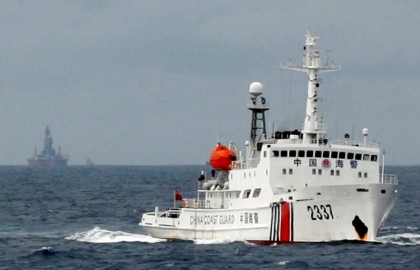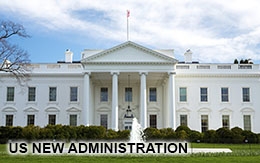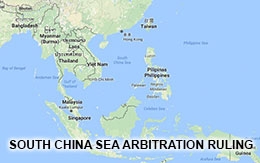De-combatising the Spratly Disputes
The possibility of standoffs among the Spratly disputants and especially between China and the US may have increased with the ruling of the Arbitral Tribunal on 12 July 2016. The award has invalidated Beijing’s basis for Spratly patrols based on the nine-dotted line. At the same time it lends America new ground for Freedom of Navigation Operations (FONOPs) in the South China Sea (SCS). These are part of the reason for Beijing to reject the arbitration award.

The possibility of standoffs among the Spratly disputants and especially between China and the US may have increased with the ruling of the Arbitral Tribunal on 12 July 2016. The award has invalidated Beijing’s basis for Spratly patrols based on the nine-dotted line. At the same time it lends America new ground for Freedom of Navigation Operations (FONOPs) in the South China Sea (SCS). These are part of the reason for Beijing to reject the arbitration award. To most PLA strategists the ruling is significant in way of militarisation of the Spratly disputes, as it may further stimulate US FONOPs in the SCS. The Spratly disputes have been structured into the geostrategic rivalry occurring among the top powers in the region and beyond. This will further complicate the management of SCS tension. Although militarisation is the typical consequence, this paper argues that the term ‘militarisation’ is unnecessarily complicated by political meaning that requires careful definition. In addition to this, the crucial international mediatory challenge does not concern militarisation of the disputes among the claimants, but the rising levels of combat capacity between American and Chinese forces in the SCS, partially due to China’s reclamation of the islands, but more relevantly due to the 12 nautical mile (12-NM) entry. Therefore any successful demilitarisation needs to commence with de-combatisation of Sino–US naval and aerial encounters in the SCS. At the same time all claimant states and especially the outside powers need to seek the largest common denominator in SCS crisis prevention and management, the denominator that this paper defines as efforts of status quo maintenance based on commitment by all to reject any attempt to use force in seeking to resolve sovereignty disputes.
What does Beijing want in the SCS disputes?
China’s SCS policy has long been two-pronged. Domestically it works towards contributing political stability in the narrative of protecting China’s core national interests. Externally it aims to help construct a conducive regional security environment for China’s rising status in world politics, overwhelmingly through building positive Sino–ASEAN relations based on 1) charming diplomacy; and 2) promoting an Asian asymmetric economic dependence on China for growth at home. An SCS policy of constraints has been crucial to the realisation of these policy objectives. If nobody agitates, SCS dispute enjoys a low priority in Beijing’s overall policy hierarchy, both internally and abroad.
Xi Jinping’s dialectical SCS policy adjustment
The US pivot has changed the nature and fundamentals of the SCS disputes, from regional sovereignty disagreement to geostrategic strife and major power rivalry. Spratly conflicts have been conveniently leveraged for effective coalition building of ASEAN claimants vis-a-vis China, enhanced US forward military deployment, and consolidation of US-centric Asian security architecture. Western scholars’ persuasion of Asian disputants that time is on Beijing’s side has instilled a sense of urgency in resolving disputes sooner rather than later. Consensus on status quo maintenance that had underlined SCS calm for almost a decade in the 2000s has been gradually eroded by the push for dispute resolution, for example, through arbitration. A radical alteration to this status quo has emerged, escalating political tension, with the possibility of resolution reduced to zero-sum discord.
More concretely, the Xi dialectics have dictated a number of SCS policy guidelines for Beijing. First, Beijing has to strike a subtle balance between confrontation-aversion and making bold moves to shift the dynamic status quo in favour of China’s claims. Secondly, if other claimants see time on China’s side and thus push for resolution, China must take pre-emptive measures to anticipate their further encroachment. Thirdly Beijing’s countermeasures have to be proportionate toreasonable predesignated‘red lines’if they are to deescalate tension in exigent times. Fourthly, Beijing’s primary SCS policy choice remains largely reactive and retaliatory. In practice, for instance, airport building in the Spratlys was justified as a reactive act to address the miserable reality that China was the only country without a Spratly airstrip among the claimants. Fifthly, Beijing should not be constrained to respond strongly if a perceived provocation occurs, for instance, the killing of Chinese fishermen by foreign sailors.
Beijing’s status-quo preference is rationally set on handling urgent domestic and international challenges, but Xi’s readjustment does not reject tactical changes in the status quo when opportunity arises. Here the difference between strategic change and tactical change of the status quo lies in whether the map of island occupation is altered by force. Island reclamation changes the shape of reefs but not the current number of islands occupied by each claimant. It may therefore only fall into the category of tactical change of the status quo of islands. This strategic Spratly status quo disadvantages China. Yet changing the map of occupation has to be attained through use of force, which would entail currently unaffordable cost to China. The choice of land reclamation is a lesser evil under the circumstances. Despite adjustment, Beijingadheres to its SCS policy guidance: not to initiate actions that may stimulate a collective ASEAN response and military intervention by outside powers against China’s sovereignty claims. On the other hand, Beijing takes advantage of US reluctance to confront China militarily and ASEAN division on the SCS dispute, so as a great power it has considerable room in which to maneuver.
Setting ‘red lines’to protect overall interests
Under enormous constraints China has set an SCS policy and strategy that is not irredentist, confrontational, or zero-sum. The policy’s military traits have been effectively offset by China’s signing of the ASEAN Treaty of Amity and Cooperation in 2002, which legally decries use of military force.Xi’s SCS strategy is primarily meant to serve China’s domestic political need – leadership legitimacy and national interests on the one hand and Asian concerns of Chinese external behaviour on the other. So far Beijing may have observed these dialectical and even self-contradictory policy options and have achieved gains vis-à-vis other claimants. It has gainedcontrol of Huangyan/Scarborough Shoal and completed land reclamation of six reefs in the Spratlys with three airstrips built, even though the cost was high. To Beijing, without a level of policy adjustment there is no way that these gains can be achieved.
...
Dr. You Ji is Professor of International Relations, Department of Government, University of Macau.
The paper was presented at the Conference: "The South China Sea in the Broader Maritime Security of the Indo-Pacific Conference", 28-30 September 2016, Canberra, Australia. This conference is co-organized by UNSW Canberra at the Australian Defence Force Academy (ADFA), the Diplomatic Academy of Vietnam (DAV), and the Japan Institute of International Affairs (JIIA).
Click here for full text:










